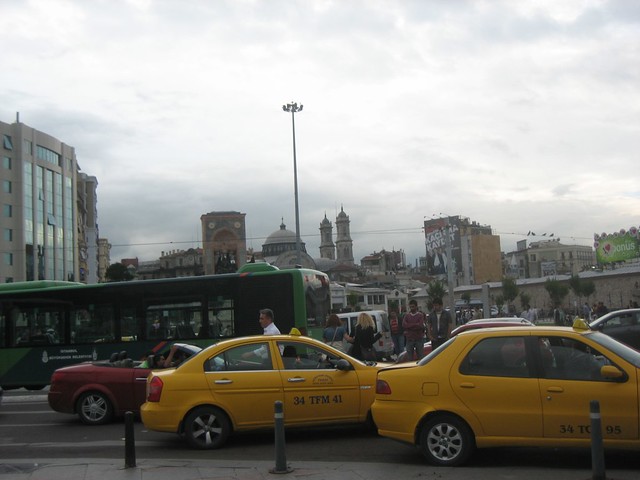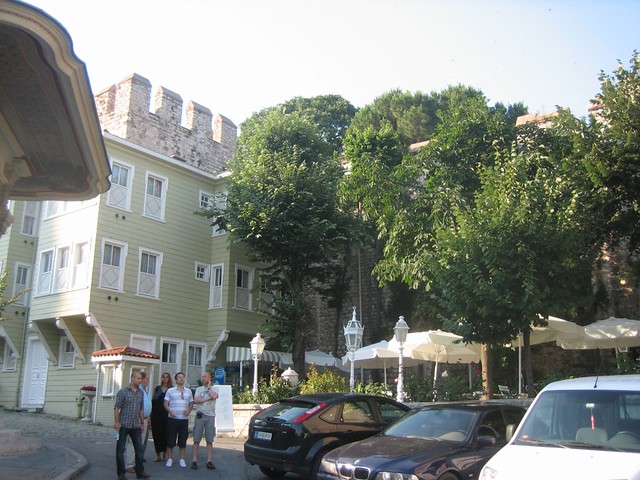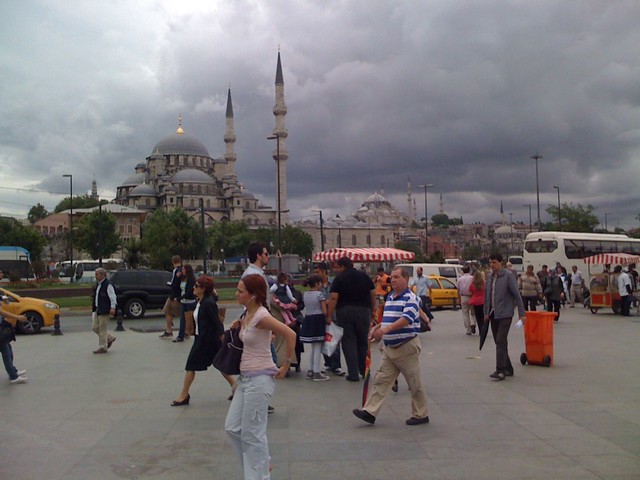This is the second blog post about what I saw while walking around Istanbul last week. Here's part 1.
Tea
I had been expecting lots of the famous "Turkish Coffee" in Istanbul. Turns out that while there is some of it around, the drink of choice in Istanbul is tea. A cup of tea costs about 40 cents, they drink it with sugar, and it is everywhere. If you thought New Yorkers were obsessed with their Starbucks, and Canadians were crazy about their Tim Hortons, that's nothing on Istanbullus and their tea. What I particularly like is that they always drink their tea - even if they're at a construction site or selling fish sandwiches from a cart - in little elegant fluted glasses with painted glass saucers and tiny spoons. Where in Canada you would see a roll-up-the-rim extra-large paper cup, in Istanbul you see these classy little tea glasses. It brings a certain urbanity to the whole activity that paper or plastic just can't.
Booze
While it's certainly present and available, alcohol doesn't seem to be a huge part of everyday life in Istanbul (unlike, say, in Halifax). Istanbullus seem to have chosen smoking as their vice of choice - and they have taken this vice to whole new levels of artfulness with their nargiles (hookahs) full of fruit-flavoured tobacco.
It's kind of refreshing to not feel pressure to drink. If you want a beer or whatever, it's available (their local beer, Efes, is pleasant on a hot day, and the few Turkish wines I've tried aren't too bad), but the general feeling is that you can have a good enough time by simply eating the great food, or maybe smoking if you feel dangerous.
There also don't seem to be ads for alcohol on TV or on billboards either. The advertising gap usually filled by alcohol, i.e. funny and occasionally surreal stories of young dudes trying to party with hot girls, seems to have been filled by snack chips and soft drinks.
Headscarves
Turkey has been dealing with the conflict between western secularism and traditional Islam ever since its founding in the early 20th century. Like elsewhere, there have been issues over the traditional headscarf. I gather that ten years ago, nobody wore the headscarf, but more recently this has changed. It seems to be particular to certain neighborhoods and economic classes, though. A lot of women wear them in the older parts of town, near the Topkapi palace and along the shore of the Golden Horn, but hardly anybody does in the more Europeanized (and richer and hipper) Galata district.
I noticed groups of people, and even some school groups, where some wore headscarves and others didn't, and nobody seemed to mind much either way. It certainly didn't seem to be a modesty thing - whoever thought headscarves implied modesty hasn't seen how some young Istanbul women can work good eye-makeup and a Hermes-style scarf, even if they were wearing the ever-popular full-length show-no-skin trenchcoat.
Interestingly, though, you don't see any headscarves in the mainstream media: none on TV shows or commercials, none on billboards or posters (except for ads for the stores where you can buy them). The official media world in every country is always different in key ways from the culture it's supposed to represent, but this was a particularly striking example.
Scams
One often feels threatened in a strange city, where one doesn't know what's dangerous and what isn't. Also, Istanbullus have a different sense of personal space than North Americans, and the culture has more hustle and wheeling-dealing than I'm used to - so what is normal for them at first felt a bit scary to me. We soon discovered that past the haranguing most people were remarkably friendly and generous.
We did get caught in one light grift though: the city has lots of shoe-polishers (Turks like their leather shoes), who wander the streets with their footstands and brushes. We were walking through a lower-class area near the Spice Market, when the shoe-polisher in front of us dropped his brush. We called to him, picked it up, and gave it back to him. He then offered to polish my boots - but while he was doing this, he pleaded with us that he had two hungry children and could we give him something? We gave him some cash and moved on - my boots were in serious need of a polish anyhow. It seemed a bit dodgy to me, but I figured he needed the money more than I did.
The next day, walking near the Suleymaniye Mosque, another shoe polisher dropped his brush in front of us. I realized that either the shoe polishers in Istanbul are extremely clumsy, or this is part of how they get gullible tourists' attention and soften them up for a donation. Over the rest of the trip we had a half dozen brushes dropped at our feet - which we deftly stepped over and ignored.
The Sounds of the City
Old Istanbul's street life has its own sound. Vendors call out their wares - especially the distinctive thrice-repeated shouts of the roast corn sellers. The ice cream lads shout. Restaurant and shop touts say "Hallo!" to passers-by. Shoe-polishers repeatedly drop their brushes in front of tourists. Car and train drivers like to honk their horns a lot - not in an angry "what the Hell are you doing - I need to get to my broker stat!" Toronto way, but more in a "hey I'm coming down the street so pedestrians might want to move to the sidewalk" way.
The long street trains that run through the city don't ring bells or beep horns, but instead make a clanging sound, sort of like a hammer hitting an anvil. As I lay in bed the first morning in town, I wondered what strange construction work was going on where people hit something once every five minutes or so.
The city has lots of mosques - besides the huge palatial ones that look like cumulus clouds bubbling above the smaller buildings, every neighborhood has several tiny ones as well - and when it's time for the Call to Prayer (several times a day) they all start playing amplified muzzein calls from speakers in their minarets, echoing through the narrow streets and overlapping one another. One doesn't see a rush of people going to these mosques, though, except on Friday.
One day while I was walking around beneath Topkapi, the call to prayer happened in the middle of a World Cup Football match - and the buzz of the vuvuzelas coming from the TVs in all of the various restaurants and patios made a great drone note to the melodies of the muezzins.
The REAL City
After almost a week in old Istanbul, I felt like I had a sense of the city. I could tell if an area was sketchy or not, and knew how to make my way through the windy streets, finding my way by minarets, like how I would find my way in Toronto by the CN Tower (which looks kind of like a minaret, come to think of it). We then took a streetcar and then a train out to the airport. After we passed through the massive Theodosian walls, we saw miles of highways, car dealerships, and high-rise apartments all the way to the airport. As we took off, the right side of the plane probably had a great view of the Golden Horn and the Bosphorus, but I was on the left side and saw, stretching all the way to the horizon, huge complexes of high rise apartments, out of Le Corbusier's wildest dreams and Jane Jacob's worst nightmares, punctuated by athletic stadiums and shopping malls.
Which is the real Istanbul? Is the city around the Golden Horn and Bosphorus like New Orleans' French Quarter, a charming historical district that is little more than a museum and doesn't really reflect the true nature of the sprawling, modern city? Or is it like Manhattan or downtown Toronto, a living, active place that just happens to be surrounded by endless suburbs? Unfortunately, I only started asking myself these questions as we left - so I guess I'll have to go back and find out some day.


